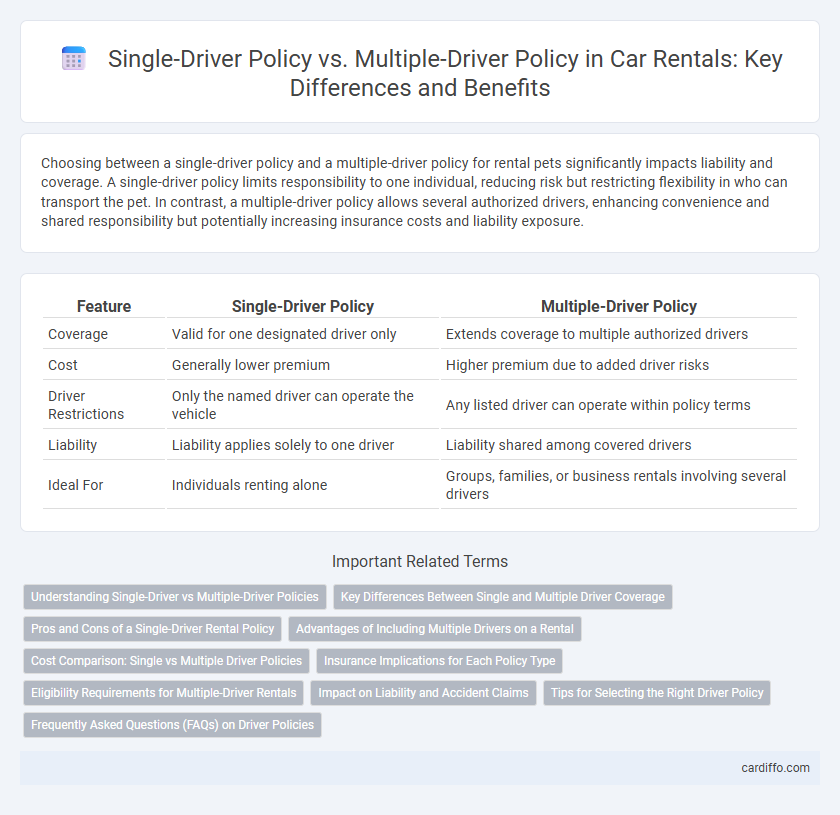Choosing between a single-driver policy and a multiple-driver policy for rental pets significantly impacts liability and coverage. A single-driver policy limits responsibility to one individual, reducing risk but restricting flexibility in who can transport the pet. In contrast, a multiple-driver policy allows several authorized drivers, enhancing convenience and shared responsibility but potentially increasing insurance costs and liability exposure.
Table of Comparison
| Feature | Single-Driver Policy | Multiple-Driver Policy |
|---|---|---|
| Coverage | Valid for one designated driver only | Extends coverage to multiple authorized drivers |
| Cost | Generally lower premium | Higher premium due to added driver risks |
| Driver Restrictions | Only the named driver can operate the vehicle | Any listed driver can operate within policy terms |
| Liability | Liability applies solely to one driver | Liability shared among covered drivers |
| Ideal For | Individuals renting alone | Groups, families, or business rentals involving several drivers |
Understanding Single-Driver vs Multiple-Driver Policies
Single-driver rental policies restrict vehicle use to one authorized driver, simplifying liability and often lowering insurance costs. Multiple-driver policies allow several named drivers, increasing flexibility but potentially raising rental fees and insurance premiums. Understanding these differences helps renters choose coverage that balances convenience, cost, and risk effectively.
Key Differences Between Single and Multiple Driver Coverage
Single-driver policies limit coverage to one designated individual, often resulting in lower premiums but restricted driver flexibility. Multiple-driver policies extend coverage to several authorized drivers, increasing premium costs but offering broader protection and shared liability. Key differences include cost variation, risk distribution, and the scope of driver authorization under each rental agreement.
Pros and Cons of a Single-Driver Rental Policy
A Single-Driver Rental Policy limits the vehicle use to one primary driver, reducing insurance complexity and potential liability by tightly controlling who operates the car. This policy often results in lower rental costs and simpler accountability for damages or violations. However, it lacks flexibility for sharing driving duties, which can lead to driver fatigue and inconvenience during long trips.
Advantages of Including Multiple Drivers on a Rental
Including multiple drivers on a rental agreement enhances flexibility by allowing seamless vehicle sharing without the need for changing contracts. It often reduces individual liability by distributing driving responsibility, which can be advantageous in case of an accident or traffic violation. Insurance coverage typically expands with multiple drivers, offering increased protection and peace of mind during the rental period.
Cost Comparison: Single vs Multiple Driver Policies
Single-driver rental policies generally offer lower base rates as they cover only one authorized driver, reducing the insurer's risk. Multiple-driver policies increase the cost due to additional risk factors associated with more drivers, often resulting in a 10-30% premium increase. Renters must compare these costs with their specific driving needs to optimize budget efficiency.
Insurance Implications for Each Policy Type
Single-driver rental policies typically offer lower insurance premiums since coverage is limited to one individual, reducing risk exposure for the insurer. Multiple-driver policies expand coverage to additional authorized drivers but often result in higher insurance costs due to increased liability and potential accident risk. Understanding the insurance implications, including premiums, liability limits, and coverage scope, is essential when choosing between single-driver and multiple-driver rental agreements.
Eligibility Requirements for Multiple-Driver Rentals
Multiple-driver rentals typically require all additional drivers to meet specific eligibility criteria such as a minimum age of 25 years, a valid driver's license held for at least one year, and a clean driving record without recent violations or accidents. Some rental companies may also require additional fees or a supplemental deposit for each extra driver. Verification of identification and insurance coverage may be necessary to ensure all drivers are authorized and covered under the rental agreement.
Impact on Liability and Accident Claims
A Single-Driver Policy restricts insurance coverage to one designated driver, concentrating liability and simplifying accident claims processing but increasing financial risk if others need to drive the vehicle. Multiple-Driver Policies extend coverage to several authorized drivers, diluting individual liability but potentially raising premiums due to higher risk exposure and complicating claims when fault among drivers is disputed. Understanding the impact of these policies on liability distribution and accident claims is crucial for renters seeking optimized financial protection and compliance with rental agreements.
Tips for Selecting the Right Driver Policy
When selecting the right rental driver policy, consider the frequency of additional drivers and their driving experience to balance coverage and cost effectively. Single-driver policies typically offer lower premiums but limit coverage to one individual, while multiple-driver policies extend protection to several authorized drivers, ideal for group travel. Evaluate your trip's needs, check insurer terms for age and driving history restrictions, and verify if added drivers require extra fees or documentation.
Frequently Asked Questions (FAQs) on Driver Policies
Single-driver policies typically limit coverage to one designated driver, reducing premiums but restricting who can legally operate the rental vehicle. Multiple-driver policies extend rental coverage to additional drivers, often requiring extra fees and the inclusion of all drivers' licenses for verification. Common FAQs address eligibility requirements, additional driver fees, and how coverage handles accidents when multiple drivers are involved.
Single-Driver Policy vs Multiple-Driver Policy Infographic

 cardiffo.com
cardiffo.com